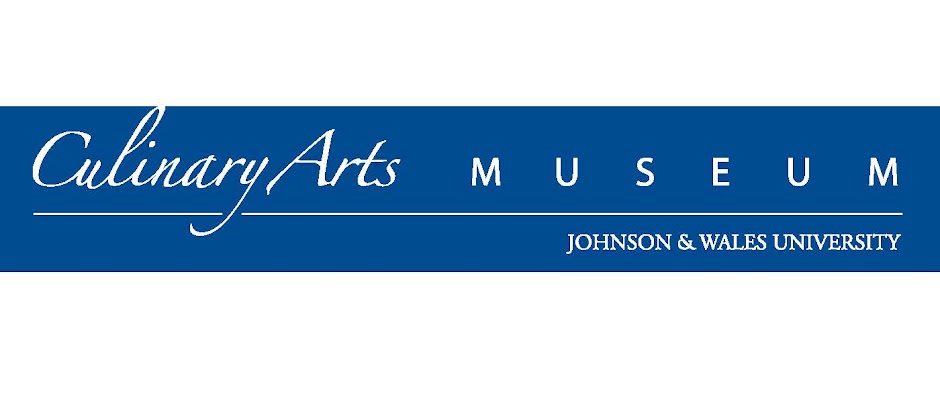 This week at JWU, Chef Marcus Samuelsson was honored as the University's 158th Distinguished Visiting Chef. He paid a visit to the Culinary Arts Museum on Monday, December 7th, and spent about an hour here. The chef had many questions for our director, Richard J.S. Gutman, about saloon, tavern, and diner culture, but he also showed a genuine enthusiasm for the students' work that is showcased here at the museum. On Tuesday December 8th, Samuelsson presented a cooking demonstration in the Amphitheater at the Harborside Academic Center. Lasting two hours, the demo was much more rousing than purely instructive -- "Chop this, measure this, stir this." While he was cooking, he shared his story: where he grew up, where he studied, where he's traveled, what he's eaten, and most importantly, what he's learned from these experiences.
This week at JWU, Chef Marcus Samuelsson was honored as the University's 158th Distinguished Visiting Chef. He paid a visit to the Culinary Arts Museum on Monday, December 7th, and spent about an hour here. The chef had many questions for our director, Richard J.S. Gutman, about saloon, tavern, and diner culture, but he also showed a genuine enthusiasm for the students' work that is showcased here at the museum. On Tuesday December 8th, Samuelsson presented a cooking demonstration in the Amphitheater at the Harborside Academic Center. Lasting two hours, the demo was much more rousing than purely instructive -- "Chop this, measure this, stir this." While he was cooking, he shared his story: where he grew up, where he studied, where he's traveled, what he's eaten, and most importantly, what he's learned from these experiences. Born in Ethiopia and raised in Sweden, Samuelsson was drawn to the kitchen at a young age by spending time with his grandmother, who was a professional chef. Samuelsson is a true inspiration, not only because of his level of success, but because of his sincere passion for food: eating it, cooking it, learning and teaching others through it. When he meets people, he asks them about their food stories, their dreams and their journeys. These stories are important to him as a means of understanding the cultural experience of these individuals and they are a source of inspiration in his work. Samuelsson thereby gains his knowledge and awareness of global culture through the palette.
Known for bringing disparate flavors together on one plate, Samuelsson continually learns from others about experimenting with cross-cultural ingredients. For example, while working on a cruise ship alongside chefs from the Philippines, the chefs there taught him that he could add coconut milk to collard greens in order to sweeten them and make them creamy. As a chef of African origins, one of his goals is to bring modern African food to Americans, just as Nobu did for Japanese cuisine. He wants to inspire those who eat his food to learn about culture through food, and to then perhaps gain an understanding and tolerance of the unfamiliar.
Samuelsson graduated from the Culinary Institute in Goteborg. He apprenticed in Switzerland, Austria, France and the US, and in 1995, at the age of 24, he was made the executive chef of Aquavit in Manhattan. Only three months later, the restaurant received a three-star review from The New York Times. Samuelsson was named 'Rising Star Chef' in 1999 and 'Best Chef, New York' in 2003 by the James Beard Foundation. The Culinary Institute of America also honored him as one of 'The Great Chefs of America.'
In addition to being the executive chef at Aquavit, he is the co-founder and chief creative director of Townhouse Restaurant Group, a restaurant management and consulting company with projects in the US and Europe. He also serves on the Board of Directors of Careers Through Culinary Arts Program (C-CAP), a non-profit organization that provides inner-city high school students with training, scholarships and jobs in the restaurant and food service industry and is an ambassador for the US Fund for UNICEF. In 2007, he became the first chef to collarborate with Starbucks Coffee, delivering bakery items and coffee blends.
Chef Samuelsson is also the author of several successful cookbooks, including Aquavit and the New Scandinavian Cuisine (2003), Aquavit c/o New York (2004), En Smakresa med Marcus Samuelsson (2002), Street Food (2004), and The Soul of a New Cuisine - Discovery of the Foods and Flavors of Africa (2006) which received accolades from publications such as The New York Times, the Chicago Tribune, and the Washington Post. It was also awarded 'Best International Cookbook' by the James Beard Foundation in 2007. His latest cookbook, New American Table was released in October of 2009.
In 2005, Samuelsson was appointed Visiting Professor of International Culinary Science at the Umea University School of Restaurant and Culinary Arts in Sweden, and he received an honorary degree from Johnson & Wales University as Doctor of Culinary Arts in 2006. Most recently, aside from being named Distinguished Visiting Chef at JWU, he was invited by the Obama family to join White House Executive Chef Cristeta Comerford in the kitchen for the State Dinner on November 24, 2009.
This is the plate of food that everyone in attendance got to taste:
Fried Yellowtail Poke with Wasabi Rouille and a Miso Ginger Vinaigrette
Here we see Baking and Pastry student Hedeline Benjamin of St. Albans, NY
learning how to filet a fish.
learning how to filet a fish.




